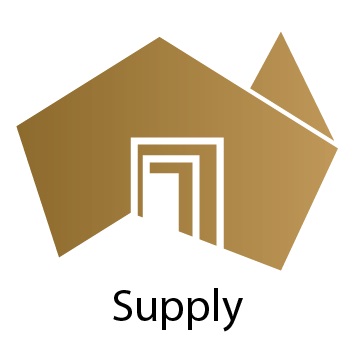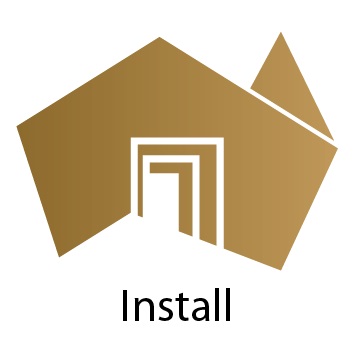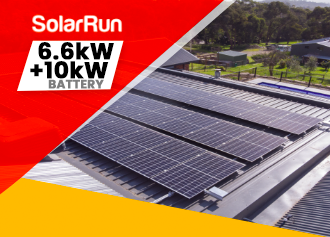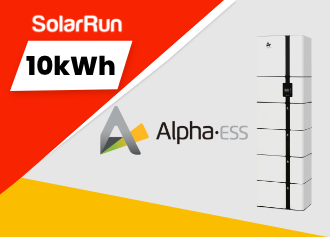 6.6kW Solar Panels
6.6kW Solar Panels

 6.6kW Solar Panels + 10kW Solar Battery
6.6kW Solar Panels + 10kW Solar Battery

 10kWh Battery Add-On
10kWh Battery Add-On

Electricity Bill before Solar $692.68
Electricity Bill after Solar $241.78.
what’s stopping you
now?
Experience reduced average electricity bills and lower your carbon emissions with our solar systems. At Solar Run, we provide the best deals on solar panels, solar inverters and solar batteries in South Australia. Our expert team is focussed on providing right advice, we take the time to understand your electricity usage patterns and then advice you of a solar system best suited to your specific requirements. Solar batteries are a great option to use your stored electricity when sunlight is not available and we have packages that include batteries. Our solar installers treat your home or business premises as their own and are super friendly. Whether you are a small family or a large commercial business, we have solar systems of all sizes. Contact us for the best solar deals in Adelaide Call 1300 076 527 now.
Jamie, a homeowner chose Solar Run for the installation of a solar panels on his roof, the perfect 6.6 kW solar system to power his home and reduce electricity bills for his family.
When Jamie decided to go ahead with solar, he first spoke with Tanya, one of our solar experts. During the consultation, she discussed Jamie’s home and how his family uses electricity daily. Tanya identified exactly what system Jamie’s family needed to reduce energy costs, and was available to offer him the best deal to meet his financial needs.
Soon after Jamie received “My Solar Design” which included a panel layout, product choice, and system price. After asking a few questions he was happy to proceed.
Enjoy a $6,000 subsidy on solar battery prices. Low-interest finance options. Switch to solar panels today and get the cheapest electricity in Adelaide. Choose Solar Run, the best solar company Adelaide trusts, and begin your clean energy transition!
With the Clean Energy Finance Corporation allocating $100 million in State Government subsidies, the Solar Battery Scheme is available to 40,000 South Australian households. This initiative, a cornerstone of the solar movement, promotes the installation of solar batteries in Adelaide and other regions of South Australia. Moreover, it reduces network demand, especially during peak times, leading to lower energy prices for all South Australians.
The subsidy is available to all South Australian homes and is based on the kilowatt-hour capacity of the solar battery purchased. Energy Concession Holders are eligible for a higher subsidy, aligning with the goal to offer the cheapest electricity in Adelaide and other South Australian regions and support low-income households in the scheme.
Contact us today to know more about the solar battery subsidy in South Australia.
A home battery system, often referred to as a solar battery system, is a device that stores excess energy generated by your solar panels. This stored energy can be used when the solar panels are not generating enough electricity, such as during night time or cloudy days. By integrating a home battery system with your solar system, you can optimise energy usage, reduce your average electricity bill, and even contribute to achieving the cheapest electricity rates.
The scheme ensures every South Australian home on the grid can purchase a subsidised solar battery system. Energy Concession Holders are eligible for a higher subsidy, aligning with the aim to provide the cheapest electricity in Adelaide and other areas and support low-income homes. To avail of the subsidy, you must choose an approved battery system from a trusted solar system provider qualified under the Scheme.
The solar battery price in Adelaide varies based on the battery’s size and whether you’re integrating it with new or additional solar panels. Please reach out to one of our friendly team members and we will be happy to guide you on choosing the right battery for your solar system.

Solar Run proudly supports The Industry Advocate’s South Australian Product Register initiative.
With Adelaide facing some of the world’s highest electricity rates, the shift to solar panels offers substantial savings for homes and businesses. Leveraging generous rebates and the benefits of renewable energy, this guide elucidates the solar options in Adelaide, empowering you to reduce costs and your carbon footprint with Solar Run.
The cost of installing solar panels are dependent on several factors. These include the number of solar panels you need, capacity and brand you choose. The overall cost of a solar system might also vary if you opt for a standard setup or decide to enhance it with solar battery storage, Q-Cells, specific inverters, or optimisers.
To give you a clearer picture of the solar panels , we’ve listed starting prices for the most common residential solar systems.
Starting Prices
Upgrades and Add-ons
Poly Panels
The most budget-friendly option, Poly Panels provide an economical gateway for those keen on transitioning to solar panels but are budget-conscious. While they might not be as efficient as other types, they’re a cost-effective solution, especially for homes with minimal energy consumption or abundant roof space for additional panels.
Mono Perc Panels
A popular choice for solar systems in Adelaide, Mono Perc Panels strike a balance between cost and efficiency. They offer homeowners a reliable and efficient solar panel system that ensures consistent energy for years without breaking the bank.
Bifacial Panels
Bifacial Panels, true to their name, harness solar energy from both sides. This dual absorption increases their efficiency by capturing direct and reflective sunlight. Though pricier and less common in Australia, they’re a top-tier choice for those prioritising power and efficiency.
After selecting on your solar panel’s power and technology, there’s a plethora of customisation options to enhance your solar system’s efficiency, power, or storage capabilities.
Inverters: A pivotal component, inverters transform the energy your panels capture into usable AC electricity. A superior inverter ensures optimal system efficiency. Pairing top-tier solar panels with a subpar inverter would result in significant energy loss during conversion.
Q-Cells: As a leading solar panel cell manufacturer, Q-Cells stand out in the market. Opting for Q-Cells can amplify your system’s output and efficiency without investing in the priciest solar systems.
Optimisers: They continuously adjust your solar panels to guarantee maximum energy returns. They not only enhance your system’s output but also address homes with shading challenges.
After determining your panel’s power, technology, and potential upgrades, the next step is selecting the right manufacturer. Each solar system manufacturer has distinct attributes concerning reputation, cost, durability, quality, extended warranty options, and design. To simplify your decision, we’ve evaluated various solar manufacturers to guide you in identifying the perfect fit for your requirements.
At Solar Run, we’re passionate about simplifying your solar experience. Choosing the right solar system for your home or business in Adelaide should be a breeze, not a puzzle. That’s why we’ve broken down the process of choosing the right system into three simple parts:
Your roof’s dimensions largely influence your solar choices.
For homes with constrained roof space, it’s crucial to opt for efficient panels to ensure adequate power generation. Conversely, residences with expansive roofs can explore options like Poly Panels. Leveraging multiple Poly Panels can be a cost-effective alternative to fewer, high-capacity panels.
Understanding your daily energy consumption is key when selecting the right solar system for your needs. Instead of making rough estimates, it’s crucial to match your daily energy use with the output of your solar panels. If you’re thinking about integrating solar batteries, it might be wise to opt for a system with a capacity large enough to store it. As a guideline, the Clean Energy Regulator recommends considering factors like your actual electricity usage, weather patterns, sun exposure, and, of course, your budget.
Don’t let partial roof shading deter you from your solar ambitions. Technological advancements offer solutions to this common issue. Two effective options for overcoming shading are optimisers and half-cell panels.
Optimisers: As previously mentioned, optimisers are a boon for homes with shaded areas. They continually adjust your solar panels to maintain peak efficiency. Unlike standard panels, which may cease to function under partial shading, a system equipped with an optimiser will continue to operate optimally.
Half-Cell Panels: These are another excellent choice for homes dealing with shading issues. By splitting the panels into two separate circuits, half-cell technology minimises the impact of shading. This allows the unshaded part of the panel to work at full capacity. Half-cell panels are robust, efficient, and a worthy upgrade to your standard solar panels in Adelaide.
Contact us today to get a quote for installing solar system in Adelaide.
Understanding Rebates in Adelaide
South Australians can access two primary rebates: Small-scale Technology Certificates (STCs) and the Hot Water subsidy.
STCs are determined by the kilowatt hours (kWh) your solar system generates. The higher the kWh output of your system, the more STCs you’ll earn. You can either sell STCs on the open market or let your CEC-accredited solar installers manage the sale, offering you an upfront discount on your system’s cost.
The hot water subsidy in Adelaide benefits those who integrate a solar hot water system. Eligible individuals can shave up to $1000 off their system’s price. Consult a CEC-accredited expert for detailed insights.
Solar Panels Payback Period
Grasping the payback period of your solar panels in Adelaide is pivotal to comprehending the Return On Investment (ROI). This period denotes the time your system requires to recoup its initial cost via energy bill savings. Post this period, your solar setup becomes profitable, consistently yielding returns. The Australian payback span typically ranges from 2-7 years, contingent on location, energy consumption, and system type.
How do Feed-in Tariffs work?
Feed-in Tariffs are credits you accrue for channelling power back to the grid, a common occurrence with most solar panels during daylight. Though these tariffs might seem minimal, over your system’s 25-year lifespan, they can culminate in substantial savings.
Potential Savings on Your Average Electricity Bill
On a broader scale, Australians are projected to save roughly $400/year/kW of their system’s power. This implies that an individual with a 10kW setup could save approximately $4,000 annually. However, exact savings hinge on the solar panel configuration. This is a foundational guide for your reference.
Simply put, solar battery storage is a recommended choice for those poised to make the initial investment. Solar batteries provide homeowners with enhanced energy autonomy, reducing reliance on the grid. It’s crucial to verify that each solar battery comes with a backup feature. With this solar battery backup, you can maintain uninterrupted electricity flow, even when the grid is down.
Yes, residents in Adelaide not only have access to solar hot water but also benefit from government subsidies for new solar hot water systems. The top three forms of hot water from renewable sources in Adelaide are heat pumps, hot water tubes, and solar hot water.
Heat pumps don’t require solar panels. Instead, they use a heat-exchange system that pulls in hot air from the exterior in exchange for cold indoor air. These systems are highly efficient in both energy and cost, with prices starting at $1,800 plus installation.
Hot Water Tubes operate on an Evacuated Tube system. As the tubes warm up through solar energy, the water gets heated and remains hot due to insulated glass layers that prevent heat loss. These systems start at $3,000 plus installation.
Solar Hot Water systems employ solar panels to heat your water tank. These systems start at $2,652 plus installation.
Three pivotal reasons underscore the wisdom of setting up a solar system in Adelaide before the year turned:
As the new year dawned, the government trimmed the discounts offered to Australians investing in solar systems. While the rebates remained, their value shrank considerably. As a result, solar systems purchased in Adelaide after this date became more expensive, lengthening the time to recoup the initial investment.
Summer in Adelaide is the ideal season to switch to solar, thanks to its longer and more potent daylight hours. This ensures that solar systems capture and convert the maximum possible solar power. Waiting until winter would have meant forgoing the prime advantages of harnessing free solar energy.
By getting a solar system up and running before Christmas, homeowners could start reaping significant savings right away. The holiday season often brings a spike in the average electricity bill in Adelaide, driven by more time spent at home, increased use of air conditioning, and festive gatherings. Switching to solar offered a way to offset these seasonal costs, turning the home into a hub of renewable energy.
Now that you have done your research, the next step is to speak with a specialist, especially if you’re considering transitioning to solar or still have questions you need clarifications on. Our dedicated team is always available to address your queries and even offer Free Quotes for those keen on adopting solar panels. To engage with one of our solar experts in Adelaide, fill out our online request form or call us at 1300 076 527 today.
We are available! Have a question? Text us here.
 Text Us
Text Us